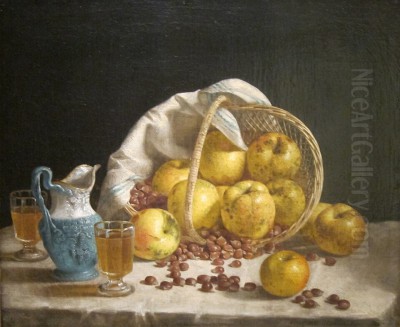
John F. Francis stands as a significant, if sometimes overlooked, figure in the landscape of nineteenth-century American art. Born in Philadelphia, Pennsylvania, on August 13, 1808, and passing away on November 15, 1886, Francis carved a distinct niche for himself primarily as a painter of still lifes, particularly those depicting inviting arrangements of food and drink, often referred to as luncheon or dessert pieces. His work is celebrated for its meticulous detail, vibrant color, and an appealing sense of abundance that resonated with the tastes of his time, yet his path to recognition and subsequent period of obscurity add layers to his artistic story.
Coming from a family of French Catholic background in the bustling artistic center of Philadelphia, Francis appears to have nurtured his artistic talents largely through self-direction. Unlike many contemporaries who sought formal training in academies or traveled abroad, Francis developed his skills through observation and practice. This self-reliant approach perhaps contributed to the unique and consistent vision evident throughout his mature work. His early career, however, was not initially focused on the genre that would define his legacy.
From Portraits to Plenty
Beginning around 1845, John F. Francis established himself as an itinerant portrait painter, traveling through central and eastern Pennsylvania to capture the likenesses of local citizens. Surviving examples from this period, such as portraits like Hezekiah B. Hazelet and Catherine Parker, demonstrate a competent hand capable of rendering individual features and conveying personality, skills foundational to any figurative artist. This phase provided him with a livelihood and likely honed his observational abilities, forcing him to carefully study form, texture, and the play of light on surfaces – elements crucial for his later still life work.
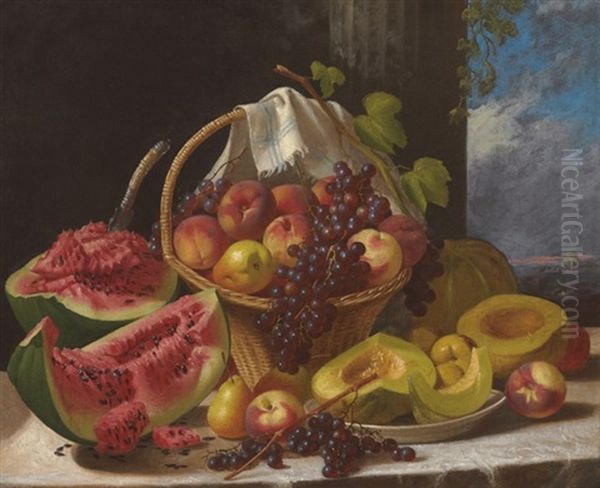
However, by the mid-1850s, a significant shift occurred in Francis's artistic focus. He turned increasingly towards still life painting, a genre gaining popularity in America at the time. This transition allowed him to move away from the demands of commissioned portraiture, which often required satisfying the sitter's vanity, towards subjects over which he had complete creative control. It was in the realm of still life that Francis found his true calling, developing a distinctive style that would bring him considerable recognition during his lifetime.
His chosen subjects often revolved around the pleasures of the table: arrangements of fruit, glistening cakes, delicate pastries, sparkling wine glasses, and gleaming silverware. These compositions, often described as "luncheon" or "dessert" pieces, tapped into a growing middle-class appreciation for domestic comfort and material abundance in mid-nineteenth-century America. They offered viewers a vicarious enjoyment of simple luxuries, presented with an appealing directness and palpable realism.
The Luncheon and Dessert Specialist
Francis quickly became one of the preeminent specialists in these appealing tabletop arrangements. His paintings often feature a characteristic richness and generosity. Works like Still Life with Wine Bottles and Basket of Fruit (1857), now housed in the Museum of Fine Arts, Boston, exemplify his approach. Here, a woven basket overflows with ripe fruit, accompanied by wine bottles, glasses, and perhaps crackers or cheese, all meticulously rendered against a typically neutral background that allows the textures and colors of the objects to take center stage.
Another notable example, Abundance of Fruit (1858), lives up to its title, presenting a lavish display that speaks to the bounty of nature and the comforts of home. The composition is carefully structured, yet feels natural and inviting. Similarly, Wine, Cheese, and Fruit (1857) combines various elements – the transparency of glass, the solidity of cheese, the varied textures of fruit – into a harmonious whole, showcasing Francis's skill in differentiating surfaces while maintaining compositional unity.
His depictions of sweets were equally masterful. Still Life with Silver Cake Basket (1866), held by the Corcoran Gallery of Art (its collection now largely dispersed, with many works going to the National Gallery of Art), likely presented a tempting cake in an ornate silver basket, highlighting Francis's ability to capture the reflective sheen of metal alongside the softer textures of baked goods. Paintings like Cherries Spilling From A Basket focus on a simpler motif but achieve impact through vibrant color – the bright red of the cherries contrasting with the greens and browns of the basket and background – and a dynamic composition suggesting casual abundance. Peaches, Pears, and Grapes would similarly focus on the inherent beauty and varied forms of common fruits.
Artistic Style: Realism, Color, and Painterly Touch
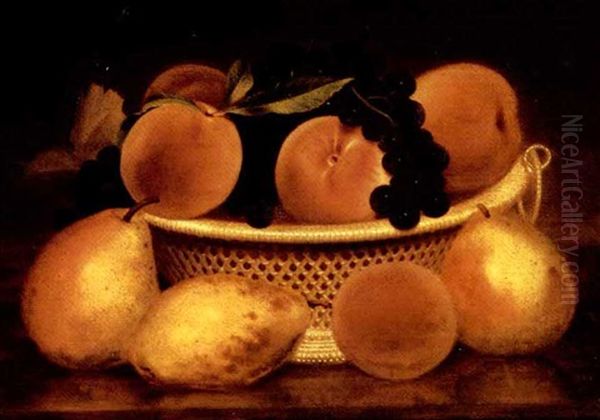
John F. Francis's style is firmly rooted in the American realist tradition of the mid-nineteenth century, yet it possesses distinct characteristics. His commitment to detailed representation is paramount. He rendered the fuzz on a peach, the subtle bloom on grapes, the precise facets of cut glass, and the weave of a basket with remarkable fidelity. This meticulousness invites close inspection and lends his subjects a tangible presence. He possessed a keen eye for the way light interacts with different surfaces, capturing reflections, transparency, and shadow with convincing accuracy.
Color is another hallmark of Francis's work. He often employed a bright, high-key palette that made his paintings stand out in exhibitions. His reds, yellows, and greens are frequently vibrant and saturated, contributing to the overall sense of vitality and optimism that pervades many of his compositions. This use of strong color contrasts sharply with the more somber tones favored by some earlier American still life painters and aligns his work with the more exuberant expressions found in artists like his contemporary, Severin Roesen.
Despite the high degree of realism, Francis's work retains a certain painterly quality. While details are precise, the brushwork is often visible, preventing the paintings from becoming cold or photographic. He achieved a satisfying balance between the accurate description of form and the expressive handling of paint, a quality noted by later art historians like William H. Gerdts, who considered Francis one of the most "painterly" still life artists of the period. This balance allows the viewer to appreciate both the illusion of reality and the artistry involved in its creation.
Influences and Context: The Peale Legacy and Beyond
Francis's emergence as a still life painter occurred within a rich tradition established earlier in Philadelphia by the renowned Peale family. Raphaelle Peale (1774-1825), son of the polymath Charles Willson Peale (1741-1827), is widely regarded as America's first professional still life painter. Raphaelle's work, known for its clarity, balanced compositions, and often austere elegance, set a high standard. Francis was undoubtedly aware of Raphaelle Peale's paintings, and scholars detect an influence in Francis's solid rendering of forms and his interest in tabletop arrangements. However, Francis developed his own distinct approach, often favoring more complex compositions and a brighter palette than Raphaelle.
The broader Peale family, including James Peale (1749-1831, Charles Willson's brother, also a notable still life painter), Rembrandt Peale (1778-1860, another son known primarily for portraits but also still lifes), and Sarah Miriam Peale (1800-1885, niece of Charles Willson, a successful portraitist), created a fertile artistic environment in Philadelphia. Francis operated within this context, absorbing lessons from the past while forging his own path.
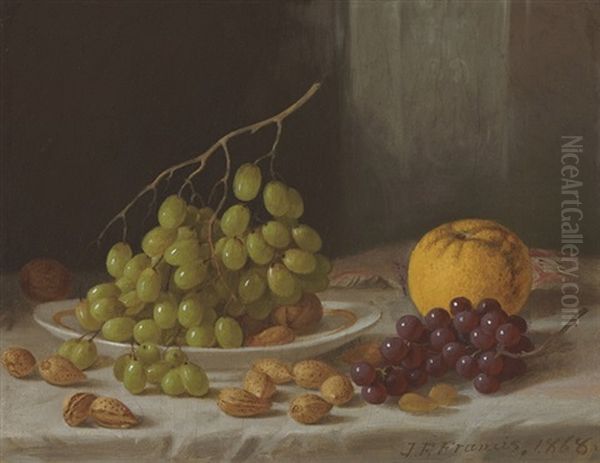
Francis's style, particularly his penchant for abundant displays of fruit and flowers, also invites comparison with Severin Roesen (c. 1815-c. 1872), a German immigrant painter who worked in Pennsylvania around the same time. Both artists created lush, detailed compositions celebrating nature's bounty, often with a similar high-key color sense. While direct influence is difficult to prove, they shared a sensibility that appealed to the optimistic spirit and material aspirations of mid-century America. Their works stand somewhat apart from the later, more illusionistic trompe l'oeil still lifes associated with artists like William Michael Harnett (1848-1892) and John Haberle (1856-1933), which often focused on masculine objects and themes of deception. Francis's work remained focused on the domestic sphere and the pleasures of the table, aligning more closely with contemporaries like George Henry Hall (1825-1913) or William Mason Brown (1828-1898), who also specialized in fruit subjects, or Paul Lacroix (fl. 1858-1869), known for his detailed fruit and floral pieces. Even Martin Johnson Heade (1819-1904), famed for his luminist landscapes and exotic hummingbirds, also produced exquisite floral still lifes that share a certain precision with Francis's work, though often with a different mood.
Exhibitions, Recognition, and a Period of Obscurity
During his peak years, from the 1850s through the early 1870s, John F. Francis enjoyed a respectable level of success and recognition. He exhibited his works regularly, primarily at institutions in his native Philadelphia. The Pennsylvania Academy of the Fine Arts (PAFA), one of the oldest and most prestigious art institutions in the country, was a key venue. He first exhibited a still life there in 1845, marking an early foray into the genre, and continued to show works there over the years.
He also participated in exhibitions organized by the Philadelphia Art Union and the Philadelphia Artists' Fund Society. These organizations played an important role in promoting American artists and cultivating public taste. They often acquired paintings and distributed them to subscribers through lottery systems, providing artists with sales and exposure while making art ownership accessible to a broader audience. Francis's participation in these venues indicates his integration into the professional art world of Philadelphia. His appealing subject matter and skillful execution likely made his works popular choices for these distribution schemes.
Despite this contemporary success, Francis's reputation began to fade towards the end of his life. After about 1872, his visibility seems to have declined, and following his death in 1886, he fell into relative obscurity for many decades. The reasons for this are likely complex, involving changing artistic tastes, a lack of aggressive self-promotion, and perhaps the fact that many of his works entered private collections and were not widely seen. Furthermore, much of his output was apparently not systematically documented, making later scholarly assessment more challenging. An intriguing, though perhaps harsh, glimpse into his later years comes from an anecdote reporting that a local clergyman, upon Francis's death, described him as possessing a character that was both eccentric and malicious – a personal assessment that hints at a potentially difficult personality but reveals little about his art.
Rediscovery and Art Historical Standing
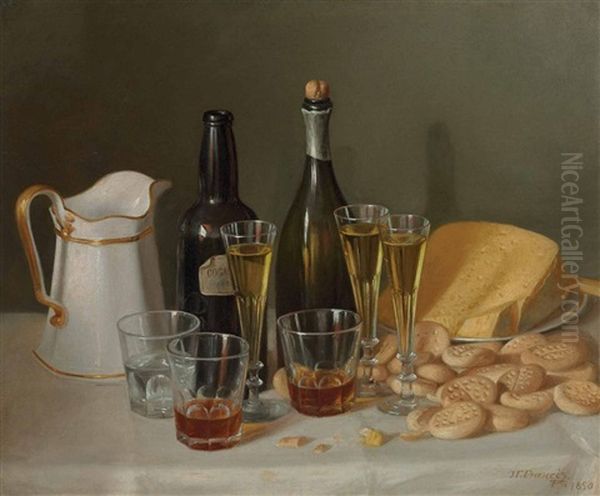
It was not until the mid-to-late twentieth century that John F. Francis's work began to be seriously re-evaluated by art historians and curators. Figures like William H. Gerdts played a crucial role in resurrecting the reputations of many nineteenth-century American still life painters who had been largely forgotten. Through scholarly publications and exhibitions, Francis's significant contribution to the genre was brought back into the light.
Today, John F. Francis is recognized as one of the leading American still life painters of the mid-nineteenth century. His work provides a vital link between the earlier tradition of the Peale family and the later developments in the genre. He successfully adapted the still life format to reflect the tastes and values of his time, creating images of appealing abundance and domestic comfort. His technical skill, particularly his handling of detail, texture, and color, is widely admired.
His specialization in the "luncheon" and "dessert" piece gives his oeuvre a distinct character. While perhaps lacking the intellectual complexity or dramatic intensity found in some other still life traditions, Francis's paintings possess an enduring charm and visual appeal. They celebrate the simple pleasures of life with sincerity and artistry. His journey from portraitist to still life specialist, his period of contemporary success followed by decades of neglect, and his eventual rediscovery make him a fascinating case study in the shifting tides of artistic reputation. While he may not have achieved the widespread fame of some contemporaries during his lifetime or immediately after, his place as a master of American still life is now secure.
Legacy in Collections
The rediscovery of John F. Francis has led to his works being acquired by major museums and appreciated by collectors. His paintings can now be found in significant public collections across the United States. As mentioned, the Museum of Fine Arts, Boston, holds the important Still Life with Wine Bottles and Basket of Fruit (1857). Works formerly in the Corcoran Gallery of Art in Washington, D.C., such as Still Life with Silver Cake Basket (1866), are now often found within the collection of the National Gallery of Art.
The Philadelphia Museum of Art, located in the city where Francis spent much of his life, also includes his work in its collection, reflecting his importance to the region's artistic heritage. Private dealers, like Godel & Co. Fine Art in New York, have handled significant pieces such as Abundance of Fruit (1858), contributing to the market's appreciation of his work. The Haas Family Collection was noted as having owned Still Life with Apples (1858), later donating it, indicating the presence of his work in prominent private hands before potentially entering public institutions. His inclusion in thematic exhibitions, such as "Better Still: Looking at Still Life in the Museum Collection," further demonstrates his recognized place within the canon of American still life painting.
Conclusion: An Enduring Appeal
John F. Francis occupies a unique and important position in American art history. As a largely self-taught artist who transitioned from portraiture to become a leading specialist in still life, he exemplifies the diverse paths taken by artists in the nineteenth century. His focus on luncheon and dessert subjects, rendered with meticulous detail, vibrant color, and a palpable sense of abundance, captured the spirit of his time while creating works of enduring visual pleasure. Though overshadowed for a period, his rediscovery has rightly placed him among the key figures of mid-nineteenth-century American realism. His paintings continue to engage viewers with their skillful execution and their celebration of the everyday comforts and simple luxuries of life, securing his legacy as a master of the American still life.